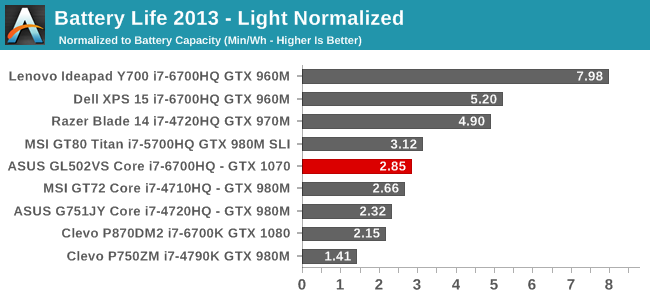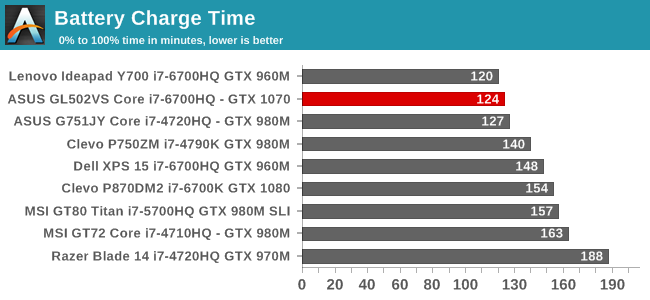The ASUS ROG Strix GL502VS Review: Mainstream GTX 1070 with G-SYNC
by Brett Howse on December 9, 2016 8:00 AM ESTBattery Life
On an Ultrabook, this section is one of the most important, but for a large gaming laptop like the ASUS GL502VS, it is very clear that this is not one of the primary focuses by the engineers. The reason for this is that the laptop has just a 62 Wh battery inside, which is about what you would get in a Dell XPS 13, and less than the Microsoft Surface Book. Some gaming laptops go for the full 99 Wh battery size. For those that are unaware, airline regulations only allow batteries in individual items of less than 100 Wh capacity, so that is the upper limit for now. ASUS has chosen to save a few dollars here and go with a much smaller battery though.
Helping matters is the lower resolution display. 1920x1080 on a 15.6-inch notebook is not high DPI at all, which will help battery life, and Intel’s Skylake lineup of CPUs has gains here too. With NVIDIA now on FinFET as well, there is a chance that the battery life can be decent.
All of our battery testing is done with the device set to 200 nits, and on wireless with the device set the default power setting.
2013 Light Battery Test

The light test involves just the browser, and opening four web pages per minute. It has become fairly simple for any of the race to sleep processors, and as such it is being phased out, but in order to give a better sample against older machines, the data is still useful.
With just a 62 Wh battery, the ASUS GL502VS ends up very near the bottom, with only the desktop CPU based Clevos below it. It falls just short of three hours on this test.
2016 Battery Life

The 2016 test is a more complex web browsing test, with more realistic page viewing. It in theory should be more taxing on the CPU than the 2013 version.
Interestingly the 2016 test follows the same result as the Clevo, with a score that is slightly higher than the older version of this test. At the end of the day, without having Optimus, the GPU still continues to be a big part of the power draw, masking the results of a bit more CPU work.
Normalized Battery Life


By removing the battery capacity from the equation, you can take a look at the overall platform efficiency. As a true gaming notebook, the ASUS GL502VS lacks NVIDIA’s Optimus technology, meaning the GPU is always running. This impacts battery life quite a bit despite the move to FinFET for Pascal.
You can see that the ASUS would have much better battery life if it just had a bigger battery. Overall efficiency is not too bad, although interestingly it is not quite as good as the SLI GTX 980M GT80 Titan. The laptops that offer Optimus, which are the Lenovo Y700, Dell XPS 15, and Razer Blade, all show a big step up in efficiency with the graphics turned off, and the Lenovo especially but it has a poor display which helps a lot. The 2016 results are a bit sparse at the moment, but will fill in over time with more devices to be tested.
Tesseract Score
Since one of the most obvious ways someone would use a laptop, even one like this, away from the wall socket is to play a movie, it makes sense to test this as well. For this we use the Tesseract score, which is simply how many times could you watch The Avengers, which is 143 minutes long.


The ASUS will get through one running of The Avengers, but if you decide to watch it another time, or just another movie, you are going to need somewhere to plug in.
Charge Time
Although the ASUS is generally going to be sitting on a desk plugged into power, there will be times where the laptop needs to be used away from the desk for a bit. Charge time can be important, especially when the overall battery life is not great.

The charge time for the ASUS is right near the top, which makes a lot of sense considering it has a much smaller than average battery to refill, but still has a hefty 180-Watt AC Adapter powering it.










54 Comments
View All Comments
nathanddrews - Friday, December 9, 2016 - link
Is $1600 mainstream?Hopefully we see FreeSync (or G-Sync) laptops on the "low end" $800 laptops. Seems like a ripe market for Adaptive Sync technologies, given the lesser performance of GTX 960m and similar parts.
close - Friday, December 9, 2016 - link
Given the prices I saw recently on deeply flawed (unbalanced) gaming machines, ~$1600 for something that comes with more than decent CPU, GPU and SSD might as well be called mainstream. The rest is still compromised as opposed to a proper gaming machine (small screen, integrated keyboard and touchpad) but at least you get a reasonable package for a relatively reasonable price.Do not compare it to a desktop. The desktop will still be twice as cheap and a lot more powerful for a long time.
xenol - Friday, December 9, 2016 - link
Find me a complete desktop system (that includes all of I/O) that performs about the same for half the cost.sorten - Friday, December 9, 2016 - link
It would be difficult to find a comparable desktop for the comparison. You could probably go with an i5 65W CPU and it would significantly outperform the laptop's 45W i7. The 1070 is the same for desktop and mobile, but much more thermal headroom on the desktop. Memory and SSDs are cheap. I also wouldn't count the cost of the monitor in the comparison, because the only time I wouldn't dock the laptop so I could use my 27" monitor would be in the rare trip to a hotel or similar place.The other thing is that anyone who is building a desktop for gaming is only replacing one or two components. For example, I could build a faster desktop gaming system than this laptop by just spending the $400 on the GPU. I've had the same case, PSU, optical drive, etc. for probably 7 or 8 years.
Samus - Sunday, December 11, 2016 - link
The other thing to keep in mind is you can build a mini ITX system with an i7 and GTX1070 while still being incredibly tiny, less expensive and more capable (aside from being slightly more bulky and lacking battery power.)But that's the real killer with gaming laptops. Unless they are DTR's, they are too weak in graphics performance, and when they are DTR's, battery life is a joke anyway.
close - Tuesday, December 13, 2016 - link
@xenol, if it's any easier for you to understand read it as "performance/$". Or do you specifically want me to lookup some desktop CPUs/GPUs that are gimped by thermal headroom to match the equivalent laptop ones, a case that allows for close to 0 upgradeability, a 15" mediocre screen, crappy keyboard, integrated buzzers... erm, speakers, and a touchpad instead of a mouse?I was talking more of a hypothetical equivalent since it's hard to build a desktop that matches *any* gaming laptop in compromises. Yeah, I get that if you want portability a laptop is the way to go. It's still a severely compromised machine, it's still extremely expensive for the hardware but maybe the difference is how much "portability" costs.
Donny2005UK - Wednesday, January 11, 2017 - link
https://www.amazon.com/Lenovo-Ideacentre-Y700-Desk... Sorry cheapest I could find with a decent cpumrmcmurren - Wednesday, February 1, 2017 - link
hey if you are intested i am selling my desktop with better specs for a great price 1200email me at mrmcmurren@gmail.com
specs as follows
BLUETOOTH: None
CASUPGRADE: None
CD: 24X Double Layer Dual Format DVD+-R/+-RW + CD-R/RW Drive (BLACK COLOR)
CD2: None
COOLANT: Standard Coolant
CPU: Intel(R) Core� i7-3820 Quad-Core 3.60 GHz 10MB Intel Smart Cache LGA2011 (All Venom OC Certified)
CS_FAN: Maximum 120MM Color Case Cooling Fans for your selected case
FA_HDD: None
FAN: Asetek 510LC Liquid Cooling System 120MM Radiator & Fan (Enhanced Cooling Performance + Extreme Silent at 20dBA) (Single Standard 120MM Fan)
FLASHMEDIA: None
GLASSES: None
HDD: 2TB (2TBx1) SATA-III 6.0Gb/s 64MB Cache 7200RPM HDD (Single Drive)
HDD2: None
IEEE_CARD: None
MEMORY: 16GB (4GBx4) DDR3/1866MHz Quad Channel Memory (Corsair Vengeance [Free upgrade from 1600MHz Major Brand])
MONITOR: None
MONITOR2: None
MONITOR3: None
MOTHERBOARD: (3-Way SLI/CrossFireX Support) ASUS P9X79 LE Intel X79 Chipset Quad Channel DDR3 ATX w/ Remote GO!, 7.1 HD Audio, GbLAN, 3 Gen3 PCIe X16, 2 PCIe X1 & 1 PCI
NETWORK: Onboard Gigabit LAN Network
OS: Microsoft(R) Windows 8 Pro (64-bit Edition)
OVERCLOCK: No Overclocking
POWERSUPPLY: 800 Watts - Standard Power Supply - SLI/CrossFireX Ready
SOUND: HIGH DEFINITION ON-BOARD 7.1 AUDIO
SPEAKERS: None
TEMP: None
TUNING: None
TVRC: None
USB: None
USBFLASH: None
USBHD: None
USBX: None
VIDEO: GTX 1070 AMP Mini
JoeyJoJo123 - Friday, December 9, 2016 - link
Desktop PCs are cheaper, and are more serviceable, and you avoid the pitfalls of going with a prebuilt system loaded with adware, or in the worst case with Lenovo's Superfish, blatant malware. However, I think you're overestimating the cost of PC ownership, and assume that a complete PC system with peripherals is _half_ the cost of a gaming laptop.GTX 1070 laptop video cards are very roughly comparable to desktop GTX 1070 performance, and Nvidia's gone a long way to help bridge the gap between mobile and desktop class performance. A balanced GTX 1070 PC build will cost ~$1000, with no peripherals or OS. Add in a basic 1080p monitor, mouse, keyboard, etc. and you're at $1250 or so. So the $1600 laptop isn't a farcry from what PC build enthusiasts would claim.
You pay about a 25% premium, I'd think for the compactness and convenience of a fully ready platform. But given that time is a resource, it's not an unjust cost for people who just want a system to be ready without the hassle of the PC building research, parts acquisition, and assembly.
These days prebuilt systems are cheaper than ever, so the argument that building your own PC saves a lot of money is losing its argument. I still do it as it's a fun hobby for me, but I know it's not for everyone.
xenol - Friday, December 9, 2016 - link
I'm poking fun of the desktop fanboy that every time they say "I can make a desktop build for cheaper!" they seem to fail to remember a laptop is a complete system. I'm all for price comparing, but please, make it as apples to apples as possible.It's like every time someone goes "I can make a $400 PC that can best a PS4" fails to account for the fact a PS4 also comes with a $60 controller and a BD drive. I mean, as a pure gaming machine, maybe. But at the same time, if I wanted something that could replace the PS4 as much as possible, I need that BD drive.
I mean, I didn't buy a PlayStation just to play games. I bought it because it's also a media player.